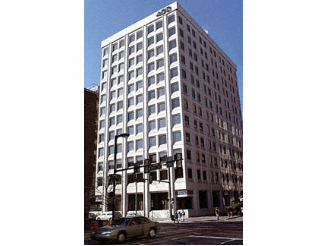Earlier this month, President Obama unveiled the Better Building Initiative (BBI), a public-private partnership that will invest $4 billion toward making federal and commercial office buildings more energy-efficient.
400 Market Street, an 11-story Philadelphia office tower built in 1972, is already serving as a model for how owners of hundreds of older, mid- and high-rise buildings throughout the Northeast and Midwest can reap the benefits of the program.
The 200,000 sf building, home to Philadelphia’s high-powered KWY-AM radio station, was recently renovated with a new HVAC system and a state-of-the-art window retrofitting system called RENOVATE by Berkowitz. According to energy modeling studies conducted with the U.S. Department of Energy’s most sophisticated energy modeling software, a typical 10- to 15-story office building like 400 Market Street could realize significant energy savings.
Developed by J.E. Berkowitz, a glass fabricator based in Pedricktown, N.J., the system works by converting existing single-pane windows into energy-saving, triple-glazed insulating glass units (IGUs) at a cost that is up to 50 percent less than ripping out and replacing old windows with new ones.
The window renovation system also has the benefit of being much faster and less disruptive to install. Berkowitz said the retrofit project for 400 Market Street took about 50 working days, which is two to three times faster than it would have been for a traditional “rip-out-and-replace” project for a similarly sized building. In addition, because the retrofitting was completed indoors, tenants were able to remain in their offices throughout the project. That is not possible with traditional window retrofitting solutions.
The BBI, which was first announced in January 2011, was developed to increase the energy efficiency in commercial buildings by 20 percent by 2020. Under the BBI, 60 private companies, municipal leaders and labor organizers have agreed on a plan to invest $2 billion of private capital to improve commercial, industrial, and manufacturing property. President Obama authorized the government to move forward with another $2 billion in energy-efficiency upgrades to federal buildings, which will be paid for by the long-term savings that the upgrades will provide. BD+C
Related Stories
Adaptive Reuse | Oct 22, 2024
Adaptive reuse project transforms 1840s-era mill building into rental housing
A recently opened multifamily property in Lawrence, Mass., is an adaptive reuse of an 1840s-era mill building. Stone Mill Lofts is one of the first all-electric mixed-income multifamily properties in Massachusetts. The all-electric building meets ambitious modern energy codes and stringent National Park Service historic preservation guidelines.
MFPRO+ News | Oct 22, 2024
Project financing tempers robust demand for multifamily housing
AEC Giants with multifamily practices report that the sector has been struggling over the past year, despite the high demand for housing, especially affordable products.
Performing Arts Centers | Oct 21, 2024
The New Jersey Performing Arts Center breaks ground on $336 million redevelopment of its 12-acre campus
In Newark, N.J., the New Jersey Performing Arts Center (NJPAC) has broken grown on the three-year, $336 million redevelopment of its 12-acre campus. The project will provide downtown Newark 350 mixed-income residential units, along with shops, restaurants, outdoor gathering spaces, and an education and community center with professional rehearsal spaces.
Office Buildings | Oct 21, 2024
3 surprises impacting the return to the office
This blog series exploring Gensler's Workplace Survey shows the top three surprises uncovered in the return to the office.
Healthcare Facilities | Oct 18, 2024
7 design lessons for future-proofing academic medical centers
HOK’s Paul Strohm and Scott Rawlings and Indiana University Health’s Jim Mladucky share strategies for planning and designing academic medical centers that remain impactful for generations to come.
Sports and Recreational Facilities | Oct 17, 2024
In the NIL era, colleges and universities are stepping up their sports facilities game
NIL policies have raised expectations among student-athletes about the quality of sports training and performing facilities, in ways that present new opportunities for AEC firms.
Codes and Standards | Oct 17, 2024
Austin, Texas, adopts AI-driven building permit software
After a successful pilot program, Austin has adopted AI-driven building permit software to speed up the building permitting process.
Resiliency | Oct 17, 2024
U.S. is reducing floodplain development in most areas
The perception that the U.S. has not been able to curb development in flood-prone areas is mostly inaccurate, according to new research from climate adaptation experts. A national survey of floodplain development between 2001 and 2019 found that fewer structures were built in floodplains than might be expected if cities were building at random.
Seismic Design | Oct 17, 2024
Calif. governor signs limited extension to hospital seismic retrofit mandate
Some California hospitals will have three additional years to comply with the state’s seismic retrofit mandate, after Gov. Gavin Newsom signed a bill extending the 2030 deadline.
MFPRO+ News | Oct 16, 2024
One-third of young adults say hurricanes like Helene and Milton will impact where they choose to live
Nearly one-third of U.S. residents between 18 and 34 years old say they are reconsidering where they want to move after seeing the damage wrought by Hurricane Helene, according to a Redfin report. About 15% of those over age 35 echoed their younger cohort’s sentiment.

















